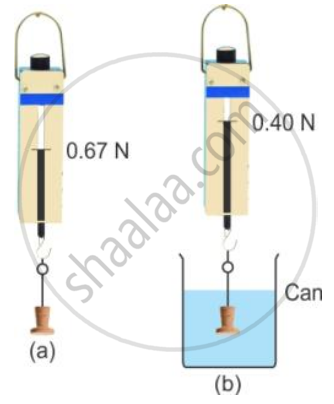Advertisements
Advertisements
Question
Describe an experiment to show that a body immersed in a liquid appears lighter than it really is.
Solution
Experiment to show that a body immersed in a liquid appears lighter:

Take a solid body and suspend it by a thin thread from the hook of a spring balance as shown in the above figure (a). Note its weight. Above figure (a) shows the weight as 0.67 N.
Then, take a can filled with water. Immerse the solid gently into the water while hanging from the hook of the spring balance as shown in figure (b). Note its weight. Above figure (b) shows the weight as 0.40 N.
The reading in this case (b) shall be less than the reading in the case (a), which proves that a body immersed in a liquid appears to be lighter.
APPEARS IN
RELATED QUESTIONS
The density of aluminium is 2.7 g cm-3 and that of brass 8.4 g cm’3. The correct statement is
Define the term Density of a substance.
For a given object, the buoyant force in liquids of different ______ is ______.
A plastic cube is released into the water. Will it sink or come to the surface of the water?
How does the liquid pressure on a diver change if:
the diver moves to the greater depth
The diagram below in Fig. 4.12 shows a device which makes the use of the principle of transmission of pressure.

- Name the parts labelled by the letters X and Y.
- Describe what happens to valves A and B and to the quantity of water in the two cylinders when the lever arm is moved down.
- Give reasons for what happens to valves A and B in part (ii).
- What happens when the release valve is opened?
- What happens to valve B in cylinder P when the lever arm is moved up?
- Give a reason for your answer in part (v).
- State one use of the above device.
Complete the following sentence :
Pressure is .................... in all directions about a point in a liquid.
Two cylindrical vessels fitted with pistons A and B of area of cross-section 8 cm2 and 320 cm2 respectively are joined at their bottom by a tube and they are completely filled with water. When a mass of 4 kg is placed on piston A, Find:
- the pressure on piston A,
- the pressure on piston B, and
- the thrust on piston B.
Complete the following sentence.
Mass = .................... × density
A beaker contains a liquid of density ‘ρ’ up to height ‘h’ such that ‘PA’ is atmospheric pressure and ‘g’ is the acceleration due to gravity. Answer the following questions:
- What is the pressure on the free surface of the liquid?
- What is the pressure on the base of the beaker?
- What is the lateral pressure at the base on the inner walls of the beaker?
